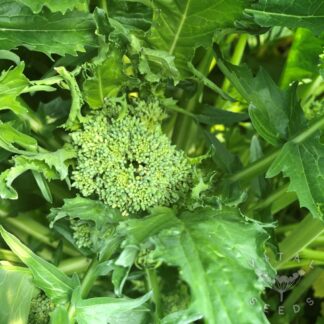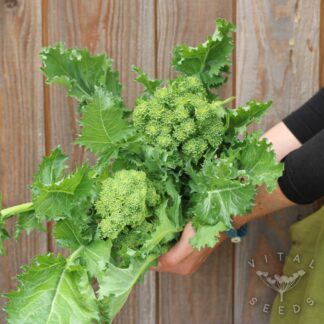Cima di Rapa
How to grow Cima Di Rapa
How to grow Cima Di Rapa
Seed Sowing
Direct sow in shallow drills 30cm apart and thin to 10-15cm within the row. Ensure your seedbed is free from weeds. Avoid sowing in midsummer as it will bolt more easily. Sow in late winter / spring for a summer harvest or towards the end of summer for an autumn crop.
Transplanting
Cima Di Rapa is best sown directly in the ground but can be sown in modules. Ideally plant out as soon as the first true leaves appear.
Plant Care
Keep the area weed-free and consistently watered during hot spells to reduce risk of bolting. You can mulch around the plants to keep in moisture and prevent weeds.
Challenges
Protect them from slugs and snails and use a fine mesh to protect from pigeons and flea beetles. Copper collars can be effective against cabbage root fly. Clubroot is a disease affecting brassicas, causing root deformities and stunted growth. If your soils have clubroot-causing organisms, improve drainage and add lime to reduce infection. Otherwise, consider growing in pots.
Harvest
The flowering shoots are harvested like sprouting broccoli and if you take care not to remove the two lower leaves you will be able to harvest a few cuts off each plant. The stalks are tender and do not need trimming.
Culinary Ideas
Cima Di Rapa is a prized staple in Italian cuisine for its sweet and slightly bitter taste, specifically in the Puglian dish ‘orrecchiette e cima di rapa’. Anchovies, pecorino, cima di rapa and garlic are served alongside Orrecchiette or ‘little ears’ pasta.
It can also be served as a side dish and cooked in a similar way to most other seasonal greens, wilted and then tossed with olive oil, lemon juice, garlic and chilli.
Seed Saving
Cima Di Rapa belongs to the species Brassica rapa and will cross with all other varieties within this species; therefore, isolate them from each other.
Sow early to ensure plants set seed in the first year of growth. It’s best to grow them in a block of at least twelve plants. Choose specimens that are true-to-type, healthy, and show traits you’d like to see in future crops. Allow plants to flower and be pollinated by insects. When the thin green seed pods turn brown and the seeds black, cut the stem and leave them to mature further on a sheet indoors. When fully dry, the pods will easily open, and the seeds will fall out. You can stomp or stand on the material, then sieve or winnow to remove the chaff.
Store in a cool dark place; seeds should remain viable for around 3 years.
Showing all 2 results
-


Cima Di Rapa – 150 days (Organic) ***NEW FOR 2026***
£2.10 Add to basketCima Di Rapa – 150 days (Organic) ***NEW FOR 2026***
Slow growing variety, also known as rapini or broccoli rabe. This variety is ready to harvest within 150 days and can be grown all year round, although best sown April-May. It is slower to make heads and bolt than San Marzano, making it slightly easier to grow.
Prized as a delicacy in Italy for its sweet and slightly bitter taste, cima di rapa translates as ‘turnip greens’, the plants produce large serrated edible leaves much like a turnip and delicate flowering florets. The leaves, stems and florets can all be eaten.
(Approximate seed count – 300) £2.10
£2.10 -


Cima di Rapa – San Marzano (Organic)
Price range: £2.10 through £3.00 Add to basket This product has multiple variants. The options may be chosen on the product pageCima di Rapa – San Marzano (Organic)
A really easy to grow broccoli alternative producing tender flowering shoots around 60 days from sowing. Cima Di Rapa (also known as broccoli raab), is actually botanically a type of turnip rather than a broccoli. As such it is very quick to grow and unfussy in terms of its water and nutrient requirements.
The flowering shoots are harvested like sprouting broccoli and if you take care not to remove the lower two leaves you can get a few cuts off them.
In Italy there are many different varieties of Cima Di Rapa, maturing at different times and with different culinary uses.
 Price range: £2.10 through £3.00
Price range: £2.10 through £3.00
Showing all 2 results




